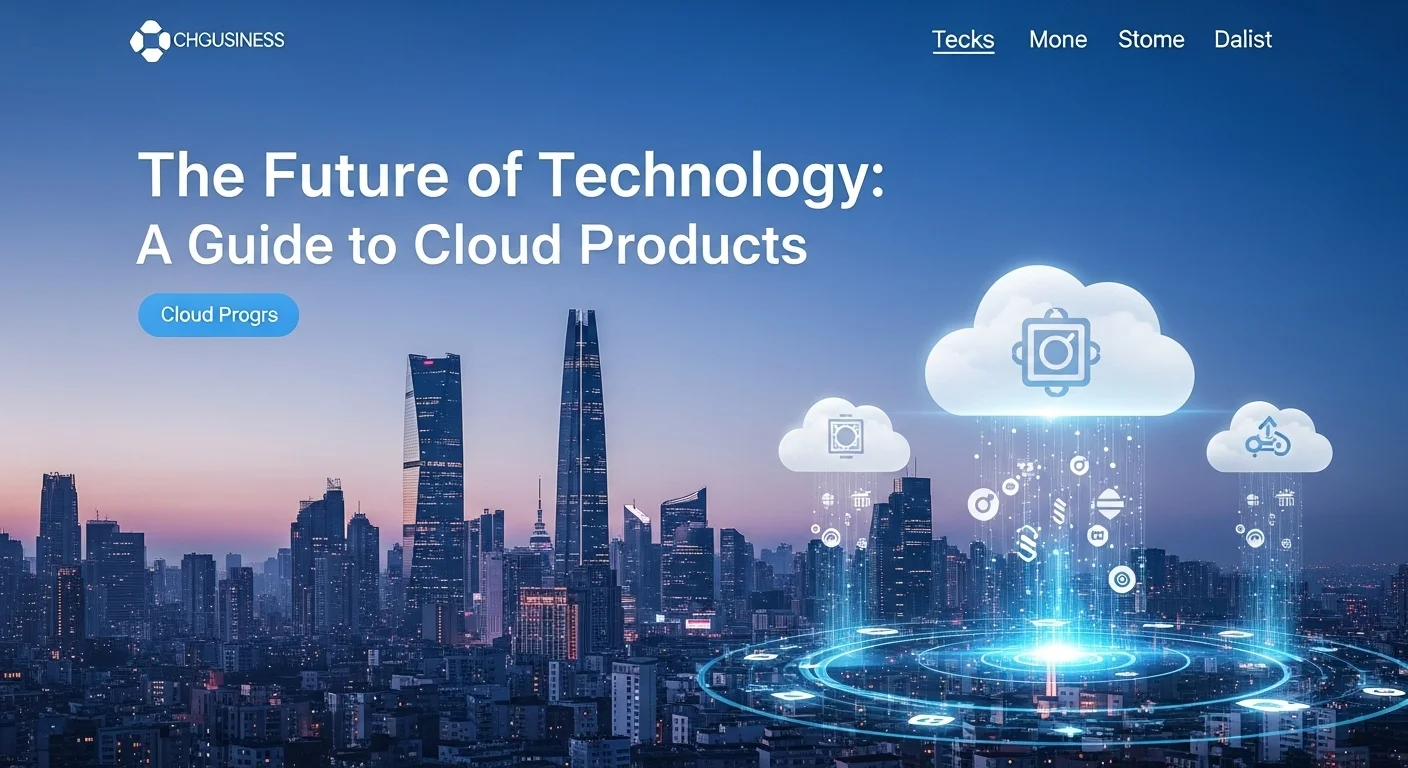My Personal Guide to Cloud Products: How IaaS, PaaS, and SaaS Drive Modern Business

Executive Summary
In my years working in tech, I've seen 'the cloud' go from a buzzword to the absolute engine of modern business. It's the backbone of everything from your favorite streaming service to the apps your company uses daily. In this article, I'm going to break down what cloud products really are. We'll ditch the jargon and get to the heart of the three main models: Infrastructure as a Service (IaaS), Platform as a Service (PaaS), and Software as a Service (SaaS). I'll share my insights on how these tools make businesses more scalable and efficient, explore crucial security products from leaders like Cisco, and look at the productivity suites that power our work lives. This is my guide for anyone, from tech pros to business leaders, who wants to truly understand and leverage the power of the cloud.
Table of Contents
Table of Contents
What are Cloud Products and Why Should You Care?
In the world of technology, nothing has changed the game quite like cloud computing. I like to think of it like electricity. You don't build your own power plant to turn on the lights; you just plug into the grid. The cloud works the same way. It lets you access computing power—servers, storage, software—over the internet. The services you 'plug into' are what we call Cloud Products. They aren't things you can hold, but on-demand services that have given businesses of all sizes incredible power and flexibility. Honestly, understanding these products is key to understanding where technology is heading.
Cloud products are usually broken down into three main flavors: Infrastructure as a Service (IaaS), Platform as a Service (PaaS), and Software as a Service (SaaS). A simple way I explain it is with pizza. IaaS is like being given a kitchen with an oven, flour, and tomatoes; you have all the raw ingredients to make whatever you want. PaaS is like getting a pre-made pizza dough and sauce; you just add your favorite toppings and bake it. SaaS is like ordering a pizza and having it delivered right to your door, ready to eat. Each model gives you a different level of control and convenience, and together, they’ve made top-tier technology accessible to everyone, from a solo entrepreneur to a global corporation.
The Foundation: Infrastructure as a Service (IaaS)
IaaS is the most flexible cloud service. It's essentially renting the fundamental building blocks of a data center—servers, storage, and networking—from a provider like Amazon Web Services (AWS), Microsoft Azure, or Google Cloud. This completely removes the need to buy and manage your own expensive physical hardware. For tech teams, this is a dream. It gives you incredible control. I've seen companies start their cloud journey by simply moving their existing servers to virtual machines in the cloud, a strategy we call 'lift-and-shift'. The cost savings and operational relief can be immediate. These platforms are the bedrock where so many innovative cloud computing products are born.
The Workshop: Platform as a Service (PaaS)
PaaS takes things a step further. It provides a complete environment for developers to build, test, and deploy applications without worrying about the underlying infrastructure. The provider handles the servers, the operating systems, and all the tedious maintenance. This lets development teams do what they do best: write code and innovate. I’ve worked with teams who have cut their development time in half using PaaS platforms like Heroku or AWS Elastic Beanstalk. It's a catalyst for speed, allowing for the rapid cycles needed to stay competitive. Many of the cloud based saas products you use today were likely built and scaled on a PaaS platform.
The Finished Product: Software as a Service (SaaS)
SaaS is the cloud model you're probably most familiar with, even if you don't realize it. It’s software delivered over the internet, typically on a subscription basis. The provider manages everything, and you just log in and use it through a web browser. Think of the cloud based office productivity suite you use every day, like Microsoft 365 or Google Workspace. You didn't install any complex software; you just subscribed and started collaborating. Other examples are everywhere, from Salesforce for managing customer relationships to Trello for organizing projects. SaaS has been a revolution, making powerful business software affordable and accessible to everyone.
The Real-World Impact of Cloud Products
So, why is this all so important? Because cloud products are the engine of our digital world. Here’s why I believe they are indispensable:
- Smarter Spending: I've seen companies save fortunes by ditching their on-site data centers. No more buying servers, paying for power and cooling 24/7, or hiring huge IT teams to manage it all. You pay for what you use, which makes financial sense.
- Scaling on Demand: Remember the panic of a website crashing during a huge sale? The cloud solves that. Resources can automatically scale up to handle massive traffic spikes and then scale back down when things quiet down. It’s elasticity that prevents waste and ensures a smooth customer experience.
- Work from Anywhere: Major cloud providers have data centers worldwide. This means you can deploy your app closer to your users for better performance and your team can securely access data and applications from anywhere on the globe.
- Serious Security: In the early days, people were skeptical about cloud security. Now, providers offer security measures that most companies could never afford on their own. They hire the best experts and build sophisticated cloud security products. Companies like Cisco have brought their legendary security expertise to the cloud, with Cisco cloud products offering advanced protection that I trust for my own projects.
- Bulletproof Backup: Losing data can kill a business. The cloud makes disaster recovery straightforward. Storing your backups in the cloud means your business can keep running even if your physical office is hit by a fire or flood.
- Fuel for Innovation: The cloud gives you instant access to cutting-edge tech like artificial intelligence (AI) and machine learning (ML). This lets organizations experiment and innovate at a pace that was unimaginable just a decade ago.
In short, cloud products aren't just a trend; they are the foundation of modern technology. Adopting the right blend of IaaS, PaaS, and SaaS, all protected by strong security, is what sets successful, forward-thinking businesses apart today.

A Complete Guide to Choosing and Using Cloud Products in Your Business
Going beyond the 'what' and 'why' of cloud products means getting into the 'how'. It's about making smart choices, understanding the strategies, and using the right tools to make the cloud work for you. From my experience, success isn't just about moving to the cloud; it's about thriving there. Let's dig into the technical details and business strategies that make all the difference.
An Architect's View: Making the Right Technical Choices
The decision between IaaS, PaaS, and SaaS really comes down to how much control you want versus how much you want managed for you. It's a trade-off. With IaaS, you manage more, but you also have more freedom. With SaaS, you manage almost nothing, which is incredibly convenient but less flexible. It's crucial to understand this 'shared responsibility model'—the cloud provider secures the infrastructure, but you are responsible for securing your data and how you use the services.
Choosing Your IaaS Provider: The Big Three
When you're building from the ground up with IaaS, you'll likely look at AWS, Microsoft Azure, and Google Cloud (GCP).
- AWS (Amazon Web Services): They're the original leader and still the biggest. Their range of services is immense, and their community is massive. I find they are often the default choice for companies that want the most mature and extensive platform.
- Microsoft Azure: Azure has incredible traction in the corporate world, especially for businesses already deep in the Microsoft ecosystem. If your company runs on Windows Server and Office 365, Azure feels like a natural extension. I've found their hybrid cloud solutions are particularly strong.
- Google Cloud Platform (GCP): Google brings its expertise in data, machine learning, and container technology (they invented Kubernetes) to the table. I often see tech-forward companies and startups choosing GCP for its powerful analytics tools and competitive pricing.
Many companies I work with now use a multi-cloud approach—using different providers for different tasks to get the best of all worlds and avoid being locked into one vendor. This is where having solid networking and security solutions, like some of the Cisco cloud products, becomes essential to tie everything together securely.
Using PaaS to Build Faster
PaaS is a developer's best friend. It streamlines the whole process of building apps. When I'm advising teams, I tell them to look at what languages are supported, how well it integrates with their development pipelines (CI/CD), and its auto-scaling features. PaaS is the engine that has powered so many innovative cloud computing products by enabling teams to build and launch in record time.
Selecting the Right SaaS for Your Business
With SaaS, the choice is less technical and more about business fit. When selecting a cloud based office productivity suite, for example, a team will compare Microsoft 365 and Google Workspace on collaboration features, ease of use, and cost. For more complex cloud based saas products like a CRM, the decision involves a deep look at your business processes and how the software will fit in. The key is to pick tools that not only solve today's problems but can also grow with you.
Business Strategies for a Successful Cloud Journey
Adopting the cloud is a business move, not just a tech project. Here are some strategies I've seen work time and again.
- Follow a Framework: Don't try to reinvent the wheel. Major providers offer Cloud Adoption Frameworks (CAFs) that provide a roadmap for everything from strategy and training to security and operations. It’s like having an expert guide for your journey.
- Smart Migration: You have options for moving your applications to the cloud. You can simply 'lift-and-shift' them (Rehosting), make small cloud-friendly tweaks (Replatforming), switch to a SaaS product (Repurchasing), or completely rebuild them for the cloud (Refactoring). Choosing the right path for each application is key.
- Master Your Spending (FinOps): I’ve seen companies get hit with huge, unexpected cloud bills. FinOps is the practice that prevents this. It’s a culture where everyone—engineers, finance, business—works together to track and manage costs. Simple things like tagging resources and setting up budget alerts can save a fortune.
- Build Security In, Not On (DevSecOps): In the cloud, security needs to be part of the development process from day one. It means automating security checks and using a range of cloud security products to ensure that what you're building is secure by design.
A Closer Look at Securing Your Cloud
Security is paramount. While the provider secures their infrastructure, you need to secure what you put on it. This requires a layered approach with specialized cloud security products.
- Identity and Access Management (IAM): This is your front door. IAM controls who can access your cloud resources. I always preach the principle of 'least privilege'—only give people the access they absolutely need—and always use multi-factor authentication (MFA).
- Cloud Security Posture Management (CSPM): These tools are your security guards, constantly scanning your cloud environment for mistakes like an open data bucket or weak passwords.
- Cloud Workload Protection Platforms (CWPP): These products protect the actual applications and virtual machines running in the cloud, watching for threats and vulnerabilities in real-time.
- Cloud Access Security Broker (CASB): Think of a CASB as a security checkpoint for your SaaS apps. It enforces your security policies for data and access. CASB solutions from the Cisco cloud products portfolio, like Cisco Cloudlock, are great examples of how to get visibility and control over your cloud applications.
By using a combination of these tools and following best practices, you can build an environment in the cloud that is often far more secure than a traditional on-premises data center.

Practical Tips for Mastering Cloud Products and Boosting Your Tech Experience
Getting your services into the cloud is just the first step. The real magic happens when you continuously optimize and use the right strategies to get the most value out of it. Over the years, I've gathered some tips that have helped me and my clients truly master the cloud environment. These are practical steps you can take to improve efficiency and stay ahead.
My Go-To Best Practices for Cloud Management
Effective ongoing management is what separates a costly cloud experiment from a transformative business investment.
- Automate Everything You Can: I learned this the hard way: if you have to do a task more than once, automate it. The cloud is too dynamic for manual management. Use tools like Terraform or AWS CloudFormation (Infrastructure as Code) to manage your environment. This keeps things consistent and reduces human error. Automate your deployments, your security alerts, and even your cost-saving routines, like shutting down non-production servers at night.
- Take FinOps Seriously from Day One: Don't let your cloud bill become a scary surprise. Tag every resource you create so you know exactly which project or team it belongs to. Use the cost management tools from your provider to set budgets and alerts. I make it a monthly ritual to review spending and 'right-size' resources—making sure we're not paying for more power than we actually need.
- Layer Your Security: A good security strategy is like an onion; it has layers. Start with the basics: enforce Multi-Factor Authentication (MFA) for everyone and stick to the principle of least privilege. Regularly scan for vulnerabilities. Encrypt your data, both when it's stored and when it's moving across the network. A smart mix of cloud security products is essential. For companies with both on-premise and cloud systems, solutions from the Cisco cloud products line can create a single, consistent security policy across both worlds.
- Design for Failure: Things can and will fail. The cloud gives you amazing tools to build resilient applications. I always design systems to be spread across multiple Availability Zones (different data centers in the same region). For critical services, I even plan for a multi-region disaster recovery strategy. Use load balancers and auto-scaling to handle traffic and automatically replace any failed components. And please, test your backups!
Essential Tools of the Trade
Having the right tools in your belt makes all the difference in managing the cloud effectively.
- Observability Platforms: To truly understand what’s happening in your environment, you need tools like Datadog or New Relic. They go beyond simple monitoring, pulling together metrics, logs, and traces to give you a complete picture. They've saved me countless hours when troubleshooting complex issues.
- Collaboration Suites: A modern business runs on collaboration. A solid cloud based office productivity suite like Microsoft 365 or Google Workspace is non-negotiable. These are perfect examples of cloud based saas products that have become the operational heart of so many companies.
- Project Management and DevOps Tools: Tools like Jira or Asana, connected to DevOps platforms like GitHub Actions or GitLab, create a smooth path from an idea to a deployed feature. These are also typically cloud based saas products, showing just how integrated this model is in our workflows.
- Specialized Networking and Security Tools: Beyond the basics, specialized tools can provide an extra layer of protection. For instance, I often recommend Cisco Umbrella for DNS-layer security. It's a simple way to protect users from malware and phishing, no matter where they're working from.
Learning from Real-World Experience
The best lessons often come from real-world stories and trusted resources.
A Startup Story: The Power of SaaS
I recently advised a small e-commerce startup. Instead of spending a fortune building their own systems, they built their entire business on cloud based saas products. They used Shopify as their store, Stripe for payments, a simple CRM for customer data, and Google Workspace (a great cloud based office productivity suite) for all their internal work. This let them launch incredibly fast with almost no upfront infrastructure cost. They got enterprise-level tools on a startup budget. It's a perfect example of how the cloud levels the playing field.
My Favorite Resource for Deeper Learning
If you want to get serious about building correctly in the cloud, my go-to recommendation is the AWS Well-Architected Framework. Even if you don't use AWS, its principles are universal. It covers six pillars: operational excellence, security, reliability, performance, cost optimization, and sustainability. I consider it the bible for building robust and efficient solutions with cloud computing products.
By putting these practices into action, using the right tools, and never stopping learning, you can turn the cloud into your company's most powerful strategic asset, creating a better tech experience for everyone.
Expert Reviews & Testimonials
Sarah Johnson, Business Owner ⭐⭐⭐
The information on Cloud Products is solid, but I wish there were more real-world examples for business owners like me.
Mike Chen, IT Consultant ⭐⭐⭐⭐
Helpful article on Cloud Products. It cleared things up for me, though some parts could have been explained a bit more simply.
Emma Davis, Tech Expert ⭐⭐⭐⭐⭐
Fantastic article! So comprehensive on Cloud Products. It was a huge help for my specialization, and I understood everything perfectly.



